2017 AWARD WINNERS
First place ($300 award): Rebecca Boehning
A Semiconductor Rose by Any Other Name
To quote Shakespeare, “A rose by any other name would smell as sweet”- however, the “roses” in my photo are not true roses at all. These miniature roses are made from organic semiconductor crystals. They are approximately 100 microns in diameter, which is the width of a human hair. While these crystals can reflect any color of light, I have colored them red to increase the contrast and enhance the imagination. My research focuses on understanding the crystal growth of organic semiconductors. While most semiconductor materials are inorganic, such as silicon, the compounds I work with offer an organic alternative. Organic semiconductors, if used effectively, offer several benefits such as flexible electronic applications and low energy manufacturing compared to silicon wafers. Before organic semiconductors can be used industrially, the underlying crystallization mechanism must be understood. While the image shown here would not make an effective electronic device, the rose-shape of these crystals abstractly portray their organic character. In the future, organic semiconductors can provide a viable alternative for commonly used semiconductors today– or, in other words, an organic semiconductor by any other name would work as well.
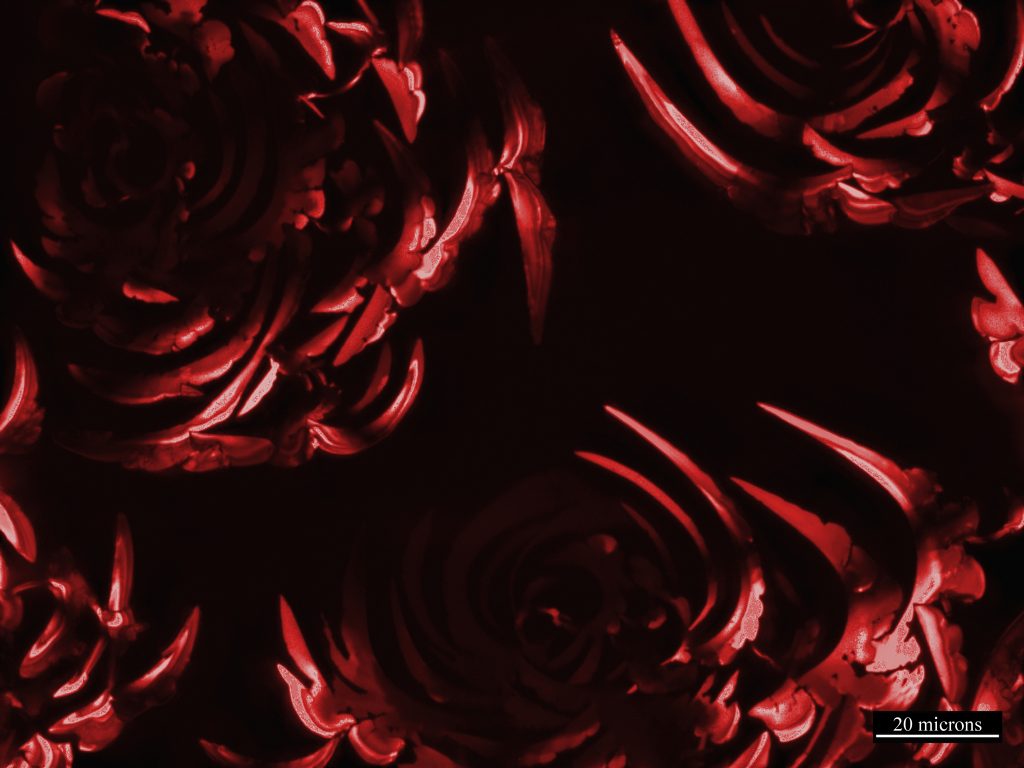
Second place ($200 award): Andrew Tran
Colorful Emotions
Roses are red, violets are blue, and octopuses are green, yellow, and brown. Colors are important representations of emotions, whether in poems or in octopuses. Remarkably, the octopus already displays mastery in controlling its chromatophores – the cells in its skin that gives it the unique ability to change color – despite being only two days old. Our research studies memory integration in the peripheral nervous system of the octopus – can the octopus store memory in its eight arms? However, it would also be interesting to examine if the pigments themselves can store memory and display emotion without the need of a brain. Interestingly enough, we have already witnessed learning behavior through color change in the octopus. When threatened or angry, the octopuses would turn red, much like how our cheeks turn red when we are feeling frustrated. When communication from the brain to the arm is severed, the arm still retains the ability to change colors and interact with its surroundings. Understanding the meanings of these colors could shed light on how these organisms use color to communicate, and maybe if the green polka dots on the heart shaped tentacles of the octopus in the picture means ‘love’ or ‘back off’.
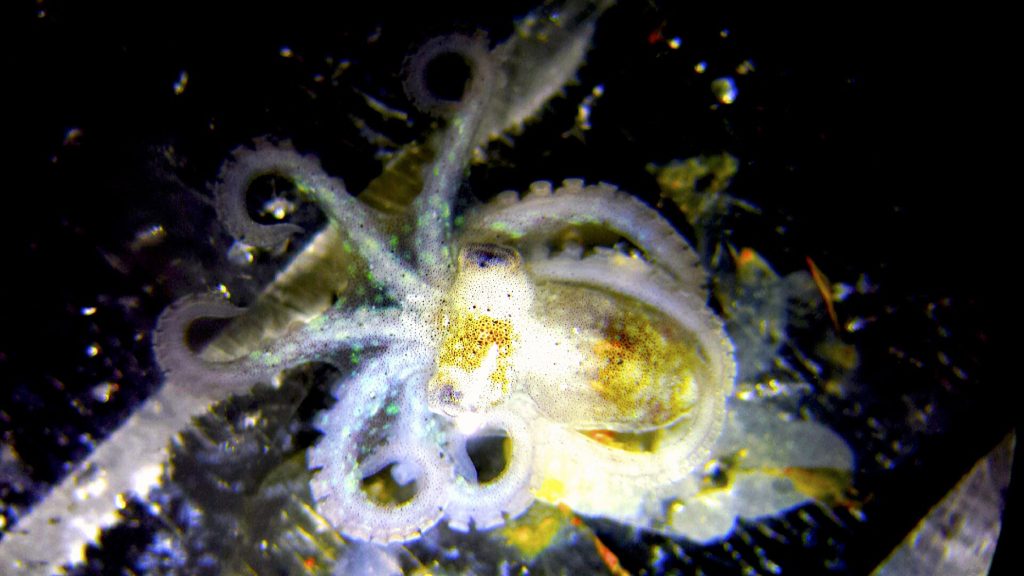
Honorable Mention ($50 award): Jesse Han
Encouraging Excellence in Planning and Design Processes and Practices in Underserved Communities
The original image was taken from a design-build project in Arusha, Tanzania. I, along with 20 other students, partnered with a local orphanage, Neema Village, to design and build a permanent home for the unadoptable children, where they could grow up with a family until adulthood. The project was a successful case study of what architecture can do when it considers the public’s interest from the beginning, throughout construction, and to occupancy. When designing, we considered the vernacular architecture along with the desires of the orphanage and learned building techniques from local craftsmen. The home is almost completely furnished and ready to house up to twelve children and a host family. Public Interest Design is a relatively new field within architecture which engages designers to use their skills to improve environments of underserved communities. Literature emerged in the form of websites, guidebooks, project analyses, and critical reflection, providing specific recommendations for practice and documenting case studies and methodologies. This paper presents the results of a comprehensive review of this literature to evaluate the breadth of existing resources for Public Interest Design and will explore how effectively the resources inform the public and train the next generation of public interest designers.

2016 AWARD WINNERS
First place ($300 award): Alexander Duman and Andrew Tran
Contributor: Rhanor Gillette
The Octopus: Eight Arms or Eight Minds?
Abstract: Octopuses expertly coordinate eight arms that contain as much as two-thirds of their entire nervous system. In fact, the arms are very sensitive and are capable of distinguishing between different textures in their environment. Our research aims to determine if learning and memory can be stored in the peripheral nervous system (PNS) of Octopus rubescens. In the picture, the octopus is using its eight arms to feel and learn how to unscrew the cap and reach the shrimp inside. We hypothesize that the arms are able to store tactile information in the PNS. To test our hypothesis, each octopus is conditioned to associate food with a roughtextured die and an electric shock with a soft-textured die. After training each arm, Lidocaine is used to block neural signaling between the PNS and central nervous system. Each die is then introduced to the arms and grasp time will be measured to determine if the PNS can store tactile information. This research has the potential to explain both the functions of the octopus nervous system as well as provide insight as to how our nervous system functions.
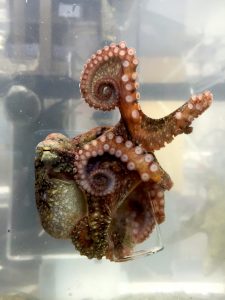
Second place ($200 award): Rebecca Boehning
Contributor: Ying Diao
Crystal Confetti
Abstract: My research focuses on growing organic semiconductor crystals. Due to the increasing popularity of computers and smart phones, semiconductors now power our world. In recent years, organic semiconductors have emerged as a potential alternative to traditional semiconductor materials, such as silicon. These organic compounds offer several benefits such as flexible electronic applications and low energy production processes (compared to silicon wafers). One common way to produce high quality organic semiconductors is via crystallization. In my research, I aim to grow large (1 mm), monochromatic crystals with defined edges. The fun (and challenging) part of growing crystals is the outcome is random! Sometimes I end up with Crystal Confetti, and other times I achieve the large, monochromatic crystals I desire. By determining favorable conditions, I hope to see the desired outcome more often. However, my undesirable samples still make great abstract art.
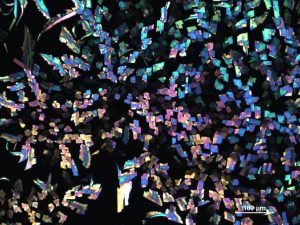
Honorable mention ($50 award): Keerthana Hogirala
Contributor: Susan Fowler
Navigating Autism During Early Childhood
Abstract: To understand how culture and income affects how parents seek medical and academic resources for their autistic children during early childhood, I travelled to Visakhapatnam, India to conduct field research for my thesis. That’s where I observed the child in this image, Keerthana. After meeting with parents, teachers, and medical professionals, I began to understand what little networked support was available for autistic children. Dealing with autism is undoubtedly complicated. Learning your young child has it in a country that doesn’t fully understand and accept neurological conditions nor support comprehensive research and education through efficient policy and funding is even more so. Solutions parents implemented were patched together from various, typically conflicting sources and mostly their own experiences. Keerthana’s mother, for instance, was highly adaptive, but that wasn’t always sufficient to help her daughter’s often hyper and indiscernible behavior, such as energetically clinging to the television for stretches of time, as shown in the image. But I saw great resilience where there was resolute familial support. Families pushed through and found a sort of isolated happiness focusing on the positive in their child. Ultimately, parents needed to feel a connection with their child as much as their child needed them.
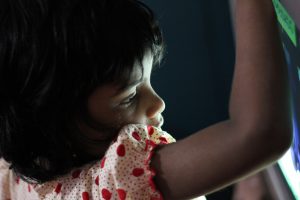
2015 AWARD WINNERS
First place ($300 award): Sean McLaughlin, Physics
Contributors: Robert J. Brunner, Anupreeta More, Kavli IPMU
Statistical Computing for Galaxy Modeling and Gravitational Lens Detection
Abstract: Strong gravitational lenses are a directly observable consequence of general relativity and one of the most exotic phenomena in the sky. However, they are extremely difficult to detect in survey images; though thousands are predicted to be visible from Earth, scientists only know of a few hundred. I’ve written a program that rapidly models the lensing galaxy and subtracts it away. It then looks at residuals in the image and analyses them for lens-like properties. This is an example of one of nearly a thousand simulated strong lenses the program was tested against. It shows the original image, the residuals after model subtraction, and the final result after the residuals have been analyzed. My advisor and I believe this technique shows promise as a strong lens detection technique in current and upcoming large scale surveys.
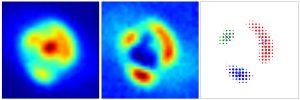
Second place ($200 award): Colin Anderson, Linguistics
Contributor: Rakesh Bhatt
The Linguistic Complexities of Complexion: Spanish and ethnicity in the United States
Abstract: Knowing nothing about the pictured people other than how they look, which of them do you think speaks Spanish? The answer may surprise you. My research is a sociolinguistic investigation on the intersection of ethnicity and second language learning in the United States. In our culture, Spanish has been racialized as Latino. This has produced a multi-faceted ideology that goes something like this: if you’re Latino you must speak Spanish, and if you speak Spanish you must be Latino; likewise, if you’re white, you probably don’t speak Spanish, or if you do, its probably bad Spanish. In light of these ideologies, it should be highly interesting to investigate the attitudes of English monolinguals toward white people who have learned Spanish as a second language and speak it with an authentic-sounding accent. I study how these speakers are evaluated socially in dimensions of solidarity and status, perceptions of their legitimacy in speaking a language associated with an ethnicity they do not belong to, as well as how second language accent and ethnicity act as warrants in being perceived as a legitimate Spanish speaker. If you’re still wondering which people in the picture speaks Spanish, the answer is everyone.
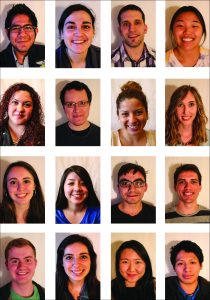
Honorable mention ($50 award): Andrew Tran, Molecular and Integrative Physiology
Contributor: Jeffrey W. Brown
Thinking Like an Octopus
Abstract: The goal of the research project is to better understand the development and organization of the peripheral nervous system of the octopus. These creatures have large ganglion in each of their arms; two thirds of the octopuss neurons are actually located in the arms nerve cords. Illustrated in the picture, the cluster of Octopus bimaculoides embryos shows early signs of intelligence. The baby octopi rapidly change color and texture using their specialized, color changing cells known as chromatophores. The minute the larvae hatched, they immediately were able to use their highly organized arms to see and mimic their surroundings. The arms also appear to work independently from one another and even serve different purposes. One arm may specialize in capturing food while the other is used for locomotion. In essence, each arm appears to have a mind of its own. Octopuses are intelligent animals, rivaling the brainpower of vertebrates such as dolphins and monkeys. Unlike these animals, octopuses are invertebrates. Understanding their intelligence may give clues to what features of the mind are universal and which are unique for different species.
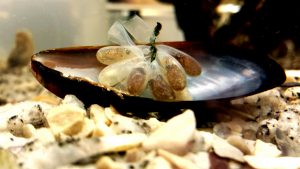
ALL AUTHORS RETAIN COPYRIGHT TO THEIR WORK.

